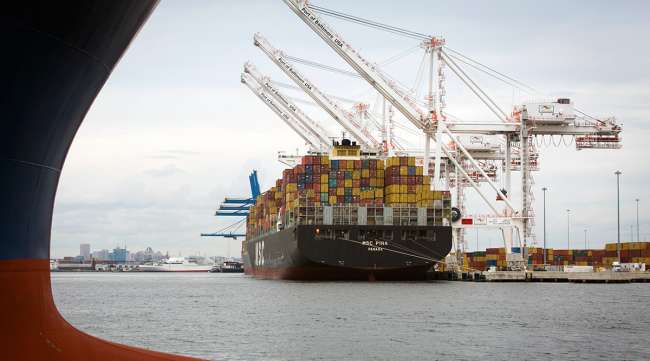Port of Baltimore Getting Six New Yard Cranes for $12 Million

Six new yard cranes will be delivered to the port of Baltimore’s Seagirt Marine Terminal on Jan. 31, a $12 million investment officials hope will help alleviate traffic congestion that has resulted from a sharp increase in the number of containers being shipped through the port in the past 18 months.
The 325,500-pound rubber-tired Gantry cranes, used move and stack containers on the docks, were purchased for a combined $12 million by Ports America Chesapeake, the private company that runs Seagirt, the container terminal, under a 50-year, $1.3 billion partnership with the Maryland Port Administration, state officials said.
“Working closely with our partner Ports America Chesapeake, our administration will continue to support the port and the thousands of hardworking Maryland men and women who rely on this crown jewel to support their families,” Gov. Larry Hogan said in a statement.
RELATED: Port of Baltimore to add new shipping service to New Zealand, Australia
Ports America Chesapeake did not respond to a request for comment Jan. 30.
Baltimore’s port remains smaller than its rivals in New York and Norfolk, Va., but it was North America’s fourth-fastest-growing port in North America in 2016, with a nearly 10% growth in general cargo, according to the Journal of Commerce.
Container growth at the port hasn’t stopped since the new Panama Canal opened in 2016, giving Asian manufacturers and shipping lines a wider shortcut to the U.S. East Coast. Baltimore handled a record 596,972 containers in 2017, an 11% increase from the previous year, officials said.
New gantry cranes arrive today at @portofbalt ! Will help get trucks in and out faster. PoB seeing record container growth as bigger ships bringing more cargo continue to arrive! @MDOTNews pic.twitter.com/DQMVVqHySe — Port of Baltimore (@portofbalt) January 31, 2018
But the increase in volume in Baltimore has come with growing pains, such as long traffic backups on Broening Highway outside the port, as truckers wait to pick up or drop off containers.
The state spent $55 million last year to expand the port for the first time in 30 years to provide adequate container capacity through 2030.
The Gantry cranes, which will be added to a current fleet of 16 currently in service, will allow longshoremen to move the boxes more quickly and get truckers through the port quicker, port spokesman Richard Scher said.
“We’ve had to adjust to the growth, and we have had some situations where we’ve had some congestion inside container terminal,” Scher said. “Even though we’ve had some significant growth over the past 18 months, it’s imperative we continue to invest with infrastructure to continue to aid that growth.”
Distributed by Tribune Content Agency, LLC

